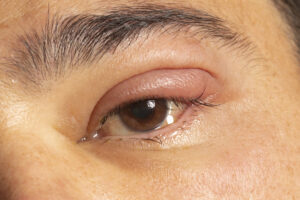A cataract is the clouding over of the typically transparent lens of the eye. To see clearly, light must pass through the lens, located behind the iris (coloured part of the eye), to reach the retina, where it is processed by the brain as an image. The lens of the eye focuses light onto the retina, so when the lens clouds, light is not able to properly reach the retina, leading to blurriness or vision loss in the eye.
What are the signs of cataracts?
Cataracts may be so mild that you do not experience any symptoms. However, as cataracts continue to develop, you may notice changes. For instance, you may experience:
- Hazy or unclear vision
- Colours appearing washed out.
- Difficulty seeing at night
- Light sensitivity, i.e. to lamps, sunlight, or headlights
- Seeing a halo around lights
- Double vision (this symptom can sometimes disappear as the cataract becomes more severe)
- Needing to update the prescription in your eyeglasses frequently
Keep in mind that these symptoms can also be indicators of other issues affecting the eyes. If you are experiencing any of these complaints, book an appointment with us as soon as possible.
Different Types of Cataracts
There are several different kinds of cataracts. Let’s go over a few of the most common types and how they present:
Nuclear Sclerosis:
At first, a nuclear sclerosis cataract can lead to increased nearsightedness, or it might even provide a temporary improvement to your reading vision. However, as time passes, the lens will gradually become yellow and cloudy, further impairing your vision.
As the cataract gradually worsens, the lens may even turn brown. If the lens has already started to become yellow or brown and is at an advanced stage, it may become difficult to differentiate between different hues of colour.
Cortical Cataracts
Yellowish and wedge-shaped opacities are the first sign of a cortical cataract. These opacities or streaks can also be described as cloudiness. As it advances, the streaks eventually reach the center of the lens, which obstructs light from entering it. With light now unable to focus properly on the retina, this creates vision loss.
Posterior Subcapsular Cataract:
Also called a posterior subcapsular cataract, this type of cataract usually begins as a small, cloudy spot. Symptoms of this type of cataract include: reading difficulty, blurry vision even in good light, and glare or halos around lights at night. Cataracts of this kind typically advance more rapidly than other kinds of cataracts do.
Congenital Cataract:
Congenital cataracts form at birth, or develop during childhood. These cataracts can be inherited, or they can be the result of an illness or trauma that occurred inside the uterus.
Several disorders, such as myotonic dystrophy, galactosemia, neurofibromatosis type 2, and rubella have been linked to the development of congenital cataracts. Cataracts that are present at birth do not always affect a person’s vision; however, if they do, the cataracts are typically removed as soon as they are discovered.








